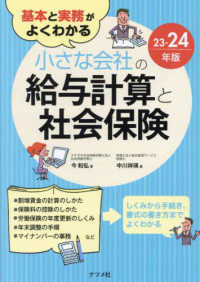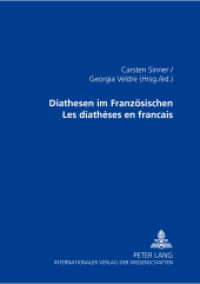Full Description
Shaped by important shifts in the field and a global pandemic, this Handbook provides a fresh look at the anthropology of death. It is split into five parts, with chapters examining how deathcare happens and the kinds of relationships that arise between the living, the dying, and the dead; how rituals change and also endure; and how societies make sense of and live with death - both everyday and catastrophic. It draws on theories of social death and necropolitics, as well as death's materiality and more-than-human experiences of death and grief, inviting a broader understanding of the subject itself. With contributors from within and beyond the fields of anthropology and death studies, it bridges gaps in scholarly dialogues around life from death and death's afterlife of mourning and memory. The ethnographically grounded individual studies combine to underscore why death matters in new and urgent ways beyond concerns of just human life.
Contents
Foreword Thomas Laqueur; Acknowledgements; Introduction Sarah L. Richardson, Sarah E. Wagner and Ruth E. Toulson; Part I. Everyday Dying and Deathwork: Introduction to Part I Sarah E. Wagner, Ruth E. Toulson and Sarah L. Richardson; 1. The work of cleaning up lonely death in Japan Anne Allison; 2. Nursing homes before and during COVID-19 Ann Neumann; 3. The circle Casey Golomski; 4. Deathcare workers and ritual change in urban China Huwy-min Lucia Liu; 5. Mastering dying: understanding end-of-life care as a cultural practice through policy Erica Borgstrom; 6. The rise of the African American undertaker and funeral directress in Baltimore, 1872-1920 Kami Fletcher; 7. Of ancestors and mourning gowns: rethinking ritual and all that it might mean Ruth E. Toulson; Part II. Materiality and the Corpse: Transformations: Introduction to Part II Ruth E. Toulson; 8. The mantelpiece urn Shannon Lee Dawdy; 9. Resistant remains: material presences and the transformability of ash Zuzanna Dziuban; 10. New 'techniques du corpse': reflections on future directions for body disposal Tamara Kohn, Hannah Gould and Bjørn Nansen; 11. Time, death, and memory: bodies in transformation Elizabeth Hallam; 12. Death and Earth deity in Vietnam Heonik Kwon; Part III. Life from Death: Introduction to Part III Sarah L. Richardson; 13. Muted martyrdom: divergent claims for life from death in capitalism Graham Denyer Willis; 14. Photos of the Inconnu: death life images from the archives of the Paris police Robert Desjarlais; 15. Generative grammars: Cuerpos Gramaticales against impunity Sarah L. Richardson; Part IV. Necropolitics: Introduction to Part IV Sarah E. Wagner, Sarah L. Richardson and Ruth E. Toulson; 16. Beyond the relic: unmaking Franco's funerary project in the Valley of the Fallen (Spain) Francisco Ferrándiz; 17. A necropolitical roadmap to 'normalization': US-Vietnamese war dead accounting and the 'sad refrain' of drifting damage Tâm T. T. Ngô and Sarah Wagner; 18. The politics of forensic identification along the US-Mexico border Robin Reineke; 19. History under the weather: political transitions, regimes of animation, and the dead in postwar Andean Peru Isaias Rojas-Perez; Part V. Beyond Death: Introduction to Part V Sarah E. Wagner, Sarah L. Richardson and Ruth E. Toulson; 20. Defending Black ancestors Aja Lans; 21. Hart Island: an ordinary massed grave Sally Raudon; 22. Biological infinitude: the decoupling of chronology and biology Abou Farman; 23. Sacred pixels: making meaning in Zoom funerals during the COVID-19 pandemic Joel C. Kuipers and Roy R. Grinker; 24. Stolen deaths in the abbreviated rites of the COVID-19 pandemic in Brazil Andreia Vicente da Silva; 25. Locating grief: pandemic memory, mourning, and the politics of where Martha Greenwald, Maria Jose Pelaez and Sarah Wagner; 26. Grieving animals Barbara J. King; Conclusion Sarah E. Wagner, Ruth E. Toulson and Sarah L. Richardson; Index.







